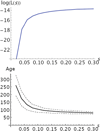Tracing pastoralist migrations to southern Africa with lactase persistence alleles
- PMID: 24704073
- PMCID: PMC5102062
- DOI: 10.1016/j.cub.2014.03.027
Tracing pastoralist migrations to southern Africa with lactase persistence alleles
Abstract
Although southern African Khoisan populations are often assumed to have remained largely isolated during prehistory, there is growing evidence for a migration of pastoralists from eastern Africa some 2,000 years ago, prior to the arrival of Bantu-speaking populations in southern Africa. Eastern Africa harbors distinctive lactase persistence (LP) alleles, and therefore LP alleles in southern African populations may be derived from this eastern African pastoralist migration. We sequenced the lactase enhancer region in 457 individuals from 18 Khoisan and seven Bantu-speaking groups from Botswana, Namibia, and Zambia and additionally genotyped four short tandem repeat (STR) loci that flank the lactase enhancer region. We found nine single-nucleotide polymorphisms, of which the most frequent is -14010(∗)C, which was previously found to be associated with LP in Kenya and Tanzania and to exhibit a strong signal of positive selection. This allele occurs in significantly higher frequency in pastoralist groups and in Khoe-speaking groups in our study, supporting the hypothesis of a migration of eastern African pastoralists that was primarily associated with Khoe speakers. Moreover, we find a signal of ongoing positive selection in all three pastoralist groups in our study, as well as (surprisingly) in two foraging groups.
Copyright © 2014 Elsevier Ltd. All rights reserved.
Figures



References
-
- Ehret C. Cattle-keeping and milking in eastern and southern African history - linguistic evidence. J. Afr. Hist. 1967;8:1–17.
-
- Güldemann T. A linguist’s view: Khoe-Kwadi speakers as the earliest food-producers of southern Africa. South Afr. Humanit. 2008;20:93–132.
-
- Pickrell JK, Patterson N, Loh PR, Lipson M, Berger B, Stoneking M, Pakendorf B, Reich D. Ancient west Eurasian ancestry in southern and eastern Africa. Proc. Natl. Acad. Sci. USA. 2014;111:2632–2637. http://dx.doi.org/10.1073/pnas.1313787111. - DOI - PMC - PubMed
Publication types
MeSH terms
Substances
Grants and funding
LinkOut - more resources
Full Text Sources
Other Literature Sources

